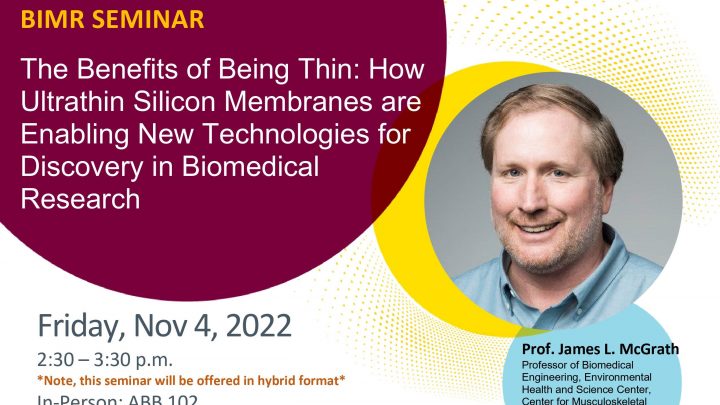The Benefits of Being Thin: How Ultrathin Silicon Membranes are Enabling New Technologies for Discovery in Biomedical Research
Nov 4, 2022
2:30PM to 3:30PM

Date/Time
Date(s) - 04/11/2022
2:30 pm - 3:30 pm
Categories
James L. McGrath, PhD
Professor of Biomedical Engineering – University of Rochester
Abstract: A decade-and-a-half after we first used silicon microfabrication to create free-standing ultrathin nanoporous membranes, the materials are being utilized by a growing number of laboratories as uniquely capable tools for biomedical research. Today we manufacture a variety of silicon-based nanoporous and microporous membranes with the common characteristics that they are ultrathin (15 nm – 300 nm) with well-defined pore sizes. The extremes thinness of ‘nanomembranes’ makes them orders-of-magnitude more permeable to both diffusing molecules and pressurized flow than conventional membranes. The ultrathin nature of the membranes also gives them a glass-like imaging quality in optical microscopy. These properties provide abundant opportunities for novel membrane-based devices and assays.
This talk will provide an overview of two leading applications of our nanoporous silicon nitride (NPN) membranes. First is their use to create in vitro models of human tissue (i.e. ’tissue chips’ or ‘microphysiological systems’). In tissue chips, the membranes provide an optically transparent and highly permeable scaffold to compartmentalize tissues including: the brain neurovascular unit, the blood-retinal-barrier, bone, and tendon. The chips are then used for reductionists studies that are providing new insights into disease mechanisms and identifying therapeutic targets. I will review our work in creating tissue chip models of the blood-brain and the blood-tendon barriers. The data will emphasize the unique imaging opportunies provided by the ultrathin membranes including live immune cell trafficking assays from the ‘blood side’ to the ’tissue side’ of these chips.
The second application I will cover is the use of NPN for cancer and immune system surveillance. Here we have leveraged our understanding of filtration through NPN to develop a digital assay of extracellular vessicles that we call ‘catch and display.’ Extracellular vessicles (EVs) are produced by all cells in the body and are deposited in all biofluids at concentrations of billions per mL. Because they carry molecular information on their tissue-of-origin as well as the potential disease states in those tissues, surveying EVs for disease is a powerful idea for minimally invasive diagnostics in cancer, infection, autoimmune disease, and more. Our data indicates that NPN provides a nearly perect substrate to physically isolate millions of individual extracellular vessicles on the membrane surface with a simple pipette injection into a microfluidic device. The membrane surface can then be rapidly imaged and analyzed to quantify the presence of biomarkers at the single EV level.
Bio: Professor McGrath holds degrees in Mechanical Engineering from Arizona State (BS) and MIT (MS) and earned a PhD in Biological Engineering from Harvard/MIT’s Division of Health Sciences and Technology in 1998. He then trained as a Distinguished Post-doctoral Fellow in the Department of Biomedical Engineering at the Johns Hopkins University. Since 2001, Professor McGrath has been on the Biomedical Engineering faculty at the University of Rochester (UR). He leads the Nanomembrane Resarch Group (NRG), a highly interdisciplinary, multi-institutional team that includes industry and academia. The NRG develops and applies ultrathin silicon-based, porous membrane technologies to applications ranging from biological ’tissues-chips’ to medical and environmental diagnostics. At UR Professor McGrath directed the BME graduate program for over a decade. He also served as the Associate Director of the microfabrication and metrology core (URNano) from 2012 until 2021 and is currently the Director of the High Content Imaging Core. He is a member of UR’s Material Science Program, the Biophysics, Structural and Computational Biology program, the Center for Musculoskeletal Research, and the Environmental Health Sciences Center. Professor McGrath is a co-founder, current director, and past president of SiMPore Inc., a company founded in 2007 to commercially manufacture silicon nanomembranes. In 2020 he co-founded Parverio, a start-up company developing technologies that surveil the environment for threats to human health, including microplastic in drinking water. In 2015 Professor McGrath was elected a fellow of the American Institute for Medical and Biological Engineering (AIMBE). He was awarded the Edmund A. Hajim Outstanding Faculty Award from the School of Engineering in 2019 and was named a Dean’s Professor of Arts Sciences and Engineering in 2022. Professor McGrath served as the Chairman of the NIH’s Instrumentation, Environmental, and Occupational Safety small business study section between 2018 and 2020. He has 12 issued and pendings patent and more than 100 scientific publications.

